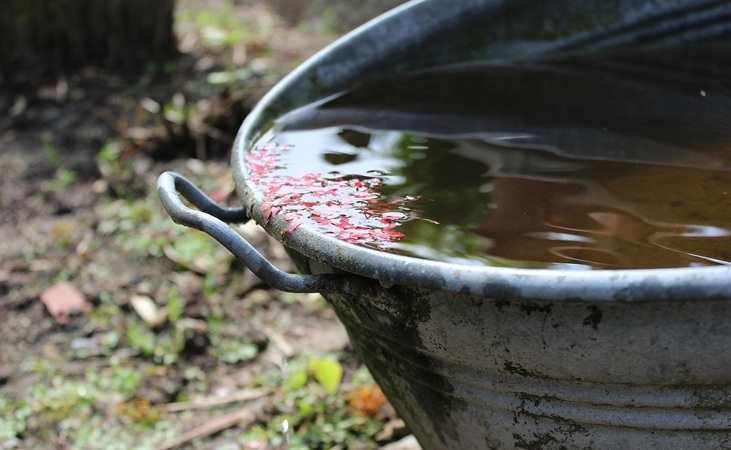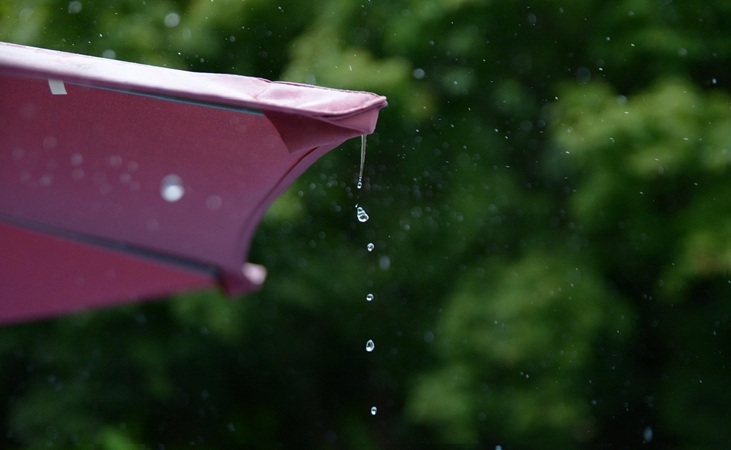Watering Plants with Rainwater

Rainwater harvesting has become more popular and more common in the UK in recent years. Whether in response to hosepipe bans and water shortages, or in anticipation of climate change and future droughts to come, there are plenty of gardeners and homeowners who have happily taken to this practice.
‘Rainwater harvesting’ can refer to something as simple as leaving a barrel out to collect rainwater or to comprehensive systems that provide water for household usage (shower, toilets and so on). UK homeowners using a rainwater harvesting system can reduce their mains water usage by 30-50%.

When we talk about rainwater storage in this article (and in others on our site), we’re coming at it from the angle of storing water to later be used for garden tasks like irrigation. But it’s certainly worth bearing in mind the full potential of harvesting and storage, because it all feeds into the concept of self-sufficiency. And after all, growing your own food is maybe one of the most common, everyday ways that people practice self-sufficiency. You might not call it that. You might just see it as a hobby or a nice way to spend time, but give yourself more credit! You’re also providing and growing food for yourself. And in some small way you’re resisting being reliant on an increasingly precarious social order.

Garland 100l Water Butt Including Tap & Lid
View ProductBenefits of Rain Water Storage
The benefits of harvesting and storing rainwater aren’t just economic. It’s good for the environment to take advantage of the natural water cycle and keep your (public) water consumption rate down.. Harvesting water from gutter and drain pipes also eases the pressure on drainage systems and reduces the incidence of flooding (or big massive puddles you have to avoid as you try to make your way inside your house).
Storing rain water means that you’ll have a back-up supply of water in the event of hose-pipe bans, shortages and public water restrictions. It’s also worth bearing in mind that the conditions that tend to give rise to those events - namely hot, dry weather - are the time when your plants need nourishing rainwater most.

Gardening Tips for Dry Weather
Related ArticlePlants Love Rainwater!
Have you ever noticed how healthy and vigorous plants and foliage look after a spell of rainy weather? It can’t be put down to coincidence. Rainwater is particularly beneficial for plants for a number of reasons.
- It’s free of chemicals like chlorine and sodium that can build up in the soil with regular irrigation and interfere with healthy plant growth if the levels are high enough.
- Rainwater contains nitrates as well as higher oxygen levels than tap water.
- The slightly acidic quality of rainwater is ideal for plant growth and nutrient absorption.
- As rainwater soaks into the soil it tends to wash away or lessen sodium build-up.

Water Butts and Containers
Water butts come in a variety of sizes, designs and storage capacities. They are a relatively low cost way of storing rainwater, mostly for garden usage or indoor plants. The typical way they work is by being connected to the gutter and downpipe of your house or shed. It’s pleasantly surprising just how much rainwater falls on the average roof.
Under normal circumstances this water ‘runs off’ into drains, and unless said drains are blocked we don’t really think too much about it. But that water is ideal for irrigating your plants with, and so the water butt is a valuable addition for anyone serious about growing food. It can be a purely functional addition, but many come in decorative antique designs, with lids that double up as planters.

Terranova Wall Tank Water Butt 275 Litre
View ProductAlgae
There’s some discussion and debate about whether some algae in stored rainwater is really that bad a thing for plants. Technically it can potentially block light, and in turn this can interfere with photosynthesis. However, there would have to be a considerable amount of algae in the water for this to be a serious concern. If you see a film of green material it’s probably nothing much to worry about when it comes to irrigation.
Acid Rain
This is something of a concern if you live in an urban area, or near heavy industrial plants etc. Heavy air pollution can lead to rain water that’s more acidic than normal. In normal conditions, rain water tends to be in a sweet spot of slight acidity. But ‘acid rain’, as you may have guessed, will push the acidity levels far enough so that the water is no longer ideal for irrigation. At pH levels below 4.0 plant growth can become stunted and the plants may not be able to take up as much nutrients.

How To Store Rainwater And Increase Its Shelf Life
To increase the shelf life of stored rainwater it’s important to keep it out of direct sunlight. This will be much easier if you’re using a purpose-built water butt or container rather than a barrel with an uncovered opening. Sunlight shining into the barrel can lead to algae growth. Using darkly coloured containers - or painting them a black or brown colour - can do a better job of keeping light out.
On the other hand, darkly coloured containers will also tend to absorb heat more, which can lead to warm standing water and the possibility of larvae and bacteria growth. You could try avoiding this dilemma by placing the container in an area that's sheltered or in the shade, but if you're connecting it to a downpipe you won't really have much choice on that front.

Garantia Antique Amphora Water Butt Sandstone
View ProductYou also may want to prevent insects, organic matter and droppings etc from finding their way into the water. Now a certain amount of organic matter in the water isn’t really a cause for alarm or frustration: after all, we use compost and mulches to feed our soil and plants. So you don’t need to seal up your water harvesting container like Fort Knox.
Do make sure that there is a filter either where the water enters the container or at the top of the gutter downspout. This will take care of nastier, larger stuff that you’d like to keep out of your water - such as (gulp) dead animals and so on. Clean the filters regularly to avoid any blockages. Ensuring that your water butt or container is adequately covered is also important from the perspective of your pets and children’s safety.

Standard Downpipe Diverter - Round or Square Profile
View ProductOne of the key ways to prevent stored rainwater from stagnating is to keep using it! You’d be hesitant to drink from a water bottle that’s been sitting in your room for a few weeks, and similar should apply to stored rainwater if you want only the best for your plants. The more water you use for irrigation and other garden tasks, the more you’ll be emptying out and refilling your container - and thus less chance of stagnant conditions or bacteria and algae growth. Water left standing for long periods can fall prey to mosquito larvae.
On that note, a layer of vegetable or fish oil can have a deterrent effect on mosquitoes (as well as other pests and insects) making their way into your storage container. The oil will float to the surface for the most part and a small amount seeping into the water won’t harm plants.

Another option here is to add some bleach to the water. Now hold up, I hear you saying. Surely one of the benefits of rainwater as opposed to tap water is the absence of chlorine? Well yes that’s true, but adding just a tiny amount of bleach (say ⅛ or ¼ of a teaspoon per gallon of water) can fight off algae while having a negligible effect (if any) on plants when you go on to use the water for irrigation.
